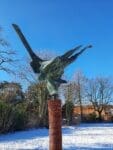IKAROS (PAUL VAN GYSEGEM)
We continue the walk in the Castrodreef and see to our right the historic ‘Exaerdekenhof’, also called ‘Castrohof’, built in 1626 by Jan van Exaerde. The name ‘Castrohof’ stems from the highly regarded noble family Don Francisco Cristobal de Castro y Toledo de Hertoghe, owners of this property. The Castrohof was altered between 1663 and 1682. Since 1971 it is a listed building. The beautiful construction lies near the Hendrik Heymanplein and is surrounded by greenery. It is built in the ‘Mosan renaissance’ style and has the traditional alternating layers of brick and stone and has a couple of remarkable chimneys. We walk around the building and see the sculpture ‘Ikaros’ at its front side, on the lawn.
The artist was happy to have ‘Ikaros’ located in these historic surroundings, the adjacent building dating from the Late Renaissance, a time when art was inspired by Greek and Roman antiquity.
Ikaros crashes into the Aegean Sea. The statue is a representation of the well-known Greek myth. Because Ikaros and his father Daidalos are being captured on Crete by king Minos, Daidalos devises a way to escape. He builds wings from a wooden frame, feathers and wax. To prevent the wax from melting he urges his son not to fly too high and too close to the sun. To prevent the wings from becoming too heavy due to seawater he shouldn’t fly too low. In his recklessness Ikaros becomes imprudent and flies too high, causing the wax to melt, with fatal consequences.
The story of Ikaros is typical of the ‘hubris’ theme, often dealt with in Greek Mythology. It illustrates how man, to this day, causes his own doom by haughtiness or over-confidence.
However, this moralistic background does not get in the way of the visual language. The artist suggests motion, a fall which cannot be checked. By its virtually abstract shapes, with flashes of recognisable elements, by its strong geometric interplay of lines and by the use of recycled materials this still is a very contemporary work.
For Paul Van Gysegem lots of materials are suitable to bring about the expressiveness of his creation. Clay, wood, metal, were all used to create this uncomplicated yet complex construction. To guarantee the stability of this falling Ikaros the bronze casting was reinforced by stainless steel elements.
VAN GYSEGEM Paul (1935)
Paul Van Gysegem is sculptor, etcher, artist designer, painter and jazz musician. He studied painting at the Academy of Gent and Free Visual Arts at the National Higher Institute of fine Arts in Antwerpen. He admires innovators like Henry Moore and his pupil Kenneth Armitage; he also admires the work of Giacomo Manzu and Marino Marini. The Flemish Parliament houses two of his etchings and two sculptures: ‘Kwintet (Quintet)’ and ‘De eeuwige terugkeer ( Eternal return)’.
- Ikaros
- Ikaros
- Ikaros
- Ikaros
- Ikaros
- Ikaros
Kunst in de Stad – October 4th 2008







